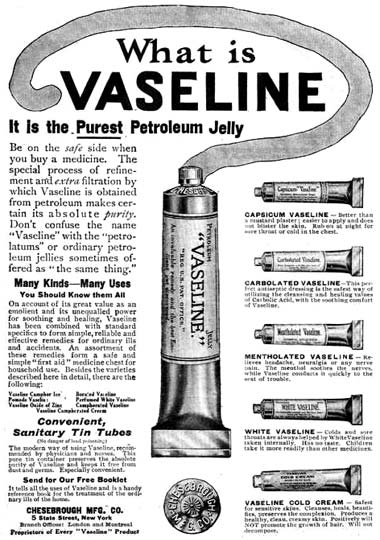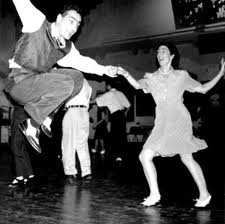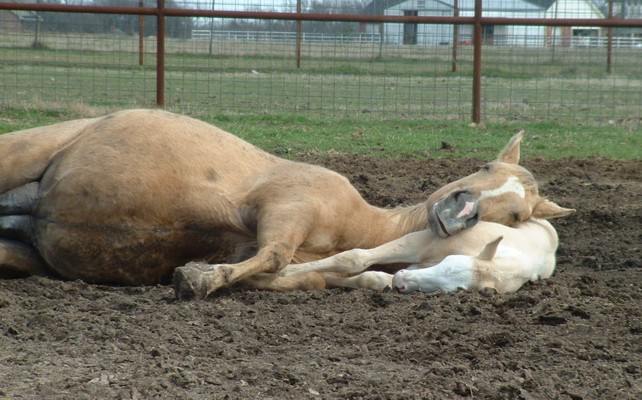The idea that the horse’s hooves are important isn’t exactly new. People have been riding horses for something like 4,000 years, and it’s my guess that the time worn (out) phrase, “No hoof, no horse” was probably invented something like 3,999 years and 364 days ago. You have a horse with good hooves – you’re lucky. You have a horse with bad hooves – not so much. If you have a horse with poor quality hooves (you know, chipping, flaking, soft, etc., etc.), you’re more than likely going to try to do anything to make them better.
Now fundamental to keeping your horse’s hooves in good shape is a shoeing and/or trimming program that is appropriate for your horse. Keep in mind that each horse should be treated as an individual, and you should work with your veterinarian and farrier to see what’s right for your horse. Not every horse needs shoes,  some horses don’t do well barefoot, some horses benefit from pads, others have problems with pads – there is no such thing as “one size fits all” when it comes to shoeing and trimming horse hooves. However, one thing that I can say with some confidence is that anyone who is particularly dogmatic about one single approach is likely to be someone that is also believes that square pegs can always fit into round holes if you just try hard enough. You’ll have to decide if that approach is something that you’re comfortable with (I’m not).
some horses don’t do well barefoot, some horses benefit from pads, others have problems with pads – there is no such thing as “one size fits all” when it comes to shoeing and trimming horse hooves. However, one thing that I can say with some confidence is that anyone who is particularly dogmatic about one single approach is likely to be someone that is also believes that square pegs can always fit into round holes if you just try hard enough. You’ll have to decide if that approach is something that you’re comfortable with (I’m not).
Anyway, when it comes to hoof treatments, they broadly fall into one of two categories.
Feed him something.
Now, as you might imagine, there are boatloads of supplements available for feeding to horses to try to improve their hoof quality. And, as you might imagine, there’s not a whole lot of out there to suggest that any of them actually work.
Probably the most commonly supplemented thing for hooves is biotin. Biotin was first discovered way back in the 1930’s. In one of those experiments where you wonder what anyone was thinking, rats developed all sorts of problems when fed a diet based on raw egg whites. In case you are wondering, rats typically don’t live on a diet of raw egg whites, and I also do not recommend that you feed your horse – or your rat, for that matter – a diet based on raw egg whites, either. Still, as it turns out, raw egg whites prevent biotin from being absorbed, and rats fed raw egg white diets get all sorts of problems, including problems with their hair coats and claws. As a result of this ground-breaking research, somebody got the idea that if you fed biotin – presumably without egg whites, or even in scrambled eggs – it might make human fingernails be less brittle. It’s not much of a logical leap to suppose that maybe biotin would be good for hooves, and pretty soon the feed store shelves were full!
NOTE: If you want to see a really good video on how to make creamy, custardy scrambled eggs, CLICK HERE. I just learned how to do it this way, and it really does make a difference.
 Biotin is a B-vitamin, which means that the bacteria in the horse’s gut probably makes all that a horse needs (in fact, that’s why your horse pretty much doesn’t need supplementation with ANY vitamin – CLICK HERE to see what I wrote about that). Biotin is in alfalfa, in pasture, and there’s even some in oats, barley, and soybeans, too. So, from the start, you have to understand that if you’re feeding your horse – if you’re feeding him anything at all – it’s going to be awfully hard to make him deficient in biotin. In fact, nobody really has any idea how much biotin a horse really needs, partly because it’s pretty much impossible to make a horse deficient in biotin. Biotin deficiencies are pretty much unheard of, and they have never been reported in the horse.
Biotin is a B-vitamin, which means that the bacteria in the horse’s gut probably makes all that a horse needs (in fact, that’s why your horse pretty much doesn’t need supplementation with ANY vitamin – CLICK HERE to see what I wrote about that). Biotin is in alfalfa, in pasture, and there’s even some in oats, barley, and soybeans, too. So, from the start, you have to understand that if you’re feeding your horse – if you’re feeding him anything at all – it’s going to be awfully hard to make him deficient in biotin. In fact, nobody really has any idea how much biotin a horse really needs, partly because it’s pretty much impossible to make a horse deficient in biotin. Biotin deficiencies are pretty much unheard of, and they have never been reported in the horse.
“So,” you say, “Dr, Ramey, does it work?” Well, you know me, I like to see what research says, and, unfortunately, when it comes to biotin, it doesn’t say much. Biotin is certainly popular, but it’s a bit frustrating if you’re trying to figure out if it actually does anything. It’s been about 20 years since the last biotin study was published, and that one was done on just four pairs of ponies, in Scotland. And in that study, the ponies that got biotin grew an extra 5 mm of hoof in five months, when compared to controls. That’s all of 1 mm per month: or about 3/100th of an inch. And, of course, you’d be trimming the hoof during that time, too. Still, earlier, South African investigators concluded that 24 horses had improvements in hoof hardness and growth rates when fed biotin. On the other hand, Swiss researches, in 1995, couldn’t find any differences between horses supplemented with biotin and those that didn’t get it.
 Then, you’ve got the, “Is there any biotin in your biotin” problem that besets all of the essentially unregulated products in the horse supplement market. That is, you don’t have any assurance that the dose that you’re intending to give is actually being given. It’s a bit of dietary Russian roulette, but, fortunately, biotin isn’t dangerous. Nobody is really looking at, or testing, products in the equine market.
Then, you’ve got the, “Is there any biotin in your biotin” problem that besets all of the essentially unregulated products in the horse supplement market. That is, you don’t have any assurance that the dose that you’re intending to give is actually being given. It’s a bit of dietary Russian roulette, but, fortunately, biotin isn’t dangerous. Nobody is really looking at, or testing, products in the equine market.
If you’re thinking about giving biotin, it won’t be difficult for you to find a supplement. They’re pretty much everywhere, and you can find just about any dose you want, since no dose has been established (most doses are in the range of 15 – 30 mg daily). It’s easy to give and horses tend to eat it well. On the other hand, it tends to be a bit pricey. Plus, if it doesn’t work, what’s the point? Of course, you have to be patient. You won’t see any immediate results, because even if it were to work, biotin would be incorporated into the new, growing hoof, and you won’t see any results for at least several months.
 Honestly, I think it’s pretty naively optimistic to expect that giving a horse a little bit of biotin biotin is going to make a big difference in your horse’s hooves, and particularly when you throw in all of the other factors, like shoeing, and trimming, and conformation, and environmental conditions, and diet. And I also think that it’s very unlikely that anyone is going to fund good studies to see if biotin works since, 1) It’s harmless, 2) Studies are time-consuming and expensive, and 3) People are buying the stuff, and why in the world would you want to spoil a good market?
Honestly, I think it’s pretty naively optimistic to expect that giving a horse a little bit of biotin biotin is going to make a big difference in your horse’s hooves, and particularly when you throw in all of the other factors, like shoeing, and trimming, and conformation, and environmental conditions, and diet. And I also think that it’s very unlikely that anyone is going to fund good studies to see if biotin works since, 1) It’s harmless, 2) Studies are time-consuming and expensive, and 3) People are buying the stuff, and why in the world would you want to spoil a good market?
In addition to biotin, there are lots of other supplements to give to horses with poor hoof quality. Some of them may contain methionine, which is an amino acid that’s found in hooves. Amino acids are the building blocks of proteins, and hoof is mostly protein, so the (simplistic) idea is that you give the horse more building blocks and he’ll build what you want. From a physiology standpoint, that rationale is sort of like giving a bunch of monkeys a bunch of typewriters and expecting them to write the Gettysburg Address. The fact is that research hasn’t supported methionine as being of benefit for growing hooves.
Now if you’ve got a horse with bad hooves, and you want to give it a hoof supplement, that’s OK by me. But don’t count on ANY supplement to overcome bad management, bad shoeing, etc. If you’re worried about your horse’s hooves, have your veterinarian evaluate things, work with your farrier, and come up with a good overall care program. Try not to keep the hooves too wet or let them get too dry (depending on where you live, of course, trying to keep your horses at a particularly amount of hydration can be a bit of a challenge). Just don’t expect too much from the supplements.
2. Put something on the hooves.
I’m not talking about shoeing and trimming here (those are other articles, which you can see if you CLICK HERE). Instead, I’m talking about hoof dressings, you know, the stuff that you can pain or rub on horse hooves to allegedly improve their quality. Here’s another area where there’s a limited amount of science, but we’ll do the best we can.
First of all, when it comes to the idea of improving hoof quality by painting something on the hoof, you need to keep in mind that the hoof is dead. Painting something on the hoof to “revitalize” it is a little bit putting fertilizer on a dead lawn. If it’s dead, it’s dead, and nothing that you put on it is going to resurrect it. So, really, you shouldn’t waste a single penny on things like hoof dressings that contain vitamins and such, because it’s not possible that the vitamins do anything (the “such” won’t do anything either).
 That said, there was one study, presented about 20 years ago at the meeting of the American Association of Equine Practitioners, that looked at the ability of hoof dressings to prevent moisture loss in hoof. To me, that’s a reasonable goal, that is, you could possibly keep hooves from losing some of their moisture if you put some sort of moisture barrier on them. Preventing moisture loss is the same reason you may put your leftovers in a plastic bag prior to putting them in the refrigerator. Researches took hoof material, and looked at loss of moisture when the material was treated with one of the two main ingredients in hoof dressings: lanolin (a grease obtained from sheep) and petrolatum (think Vaseline®).
That said, there was one study, presented about 20 years ago at the meeting of the American Association of Equine Practitioners, that looked at the ability of hoof dressings to prevent moisture loss in hoof. To me, that’s a reasonable goal, that is, you could possibly keep hooves from losing some of their moisture if you put some sort of moisture barrier on them. Preventing moisture loss is the same reason you may put your leftovers in a plastic bag prior to putting them in the refrigerator. Researches took hoof material, and looked at loss of moisture when the material was treated with one of the two main ingredients in hoof dressings: lanolin (a grease obtained from sheep) and petrolatum (think Vaseline®).
 Turns out that petrolatum is a much better moisture barrier than is lanolin, and that’s good enough for me. I’m not saying that hoof dressings are going to fix everything (back to the shoeing, environment, etc., discussion), but if you want to prevent moisture loss, I think that you’re probably better off using a product with a petrolatum base (look on the label). You could even use petrolatum ointment, which is pretty cheap when you buy a tub of it at the drug store. Heck, I even had a client that painted used motor oil on horse hooves with no ill effect – oil and water don’t mix… but I wouldn’t recommend motor oil just because of environmental concerns.
Turns out that petrolatum is a much better moisture barrier than is lanolin, and that’s good enough for me. I’m not saying that hoof dressings are going to fix everything (back to the shoeing, environment, etc., discussion), but if you want to prevent moisture loss, I think that you’re probably better off using a product with a petrolatum base (look on the label). You could even use petrolatum ointment, which is pretty cheap when you buy a tub of it at the drug store. Heck, I even had a client that painted used motor oil on horse hooves with no ill effect – oil and water don’t mix… but I wouldn’t recommend motor oil just because of environmental concerns.
Anyway, I hope that gives you some stuff to think about. Oh, one other thing, research has shown that there’s no difference between white and black hooves, so there’s one less thing you have to worry about. But if you do have a horse with bad hooves, again, start by working with your veterinarian and your farrier to identify possible causes, and fix those first. Then, if you want to try some other stuff, go ahead, you’re unlikely to hurt anything. Just don’t expect too much.








